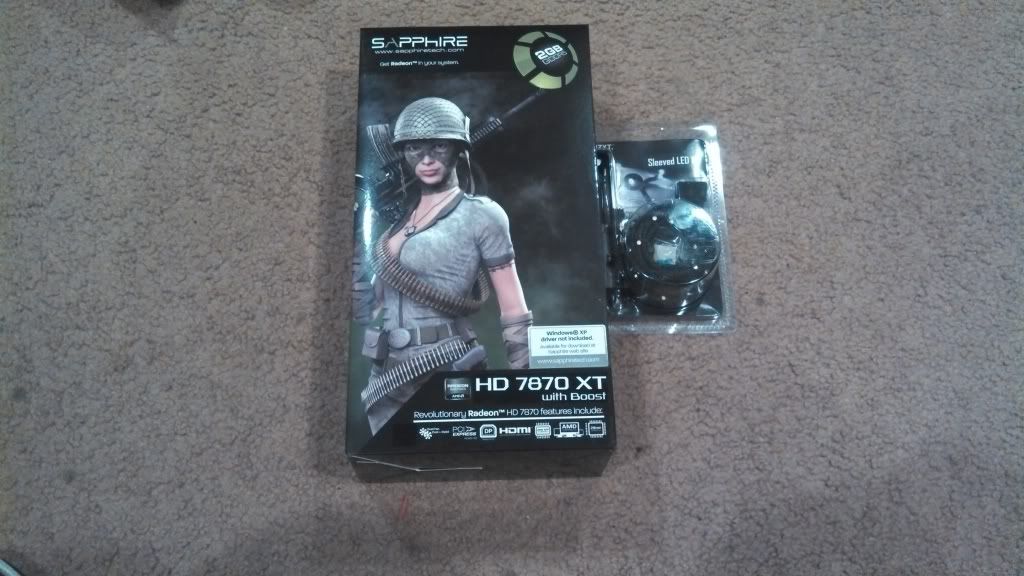There was a LOT of this screen, let me tell you...
Unfortunately, 2 weeks later there was a sense of deja vu all over again, as I ended up doing ANOTHER wipe and full reinstall, as my rig and WHS2011 were not on speaking terms for about 2 weeks or so. I couldn't do a backup to WHS2011, or do a backup through Win7. Restarting the backup services didn't seem to help either. Instead of wasting time tracking down what the problem was, it was simply easier to just start from scratch. Again. Let's see how well this one goes, shall we?
In the time since the last post I've made 3 alterations. First, I have a new monitor. My old setup had 2 17" monitors running on my computer desk (again, parts decommissioned from work). On the one hand, they were perfect for the days I had to work from home, as I could have my Outlook open on one screen and the program I use at my job open on the other, and could drag and drop between the two. I have the same setup at work (a 15" laptop and a 20" HP monitor), and after using 2 screens, it's VERY hard to go back. That said, the monitors I was working with at home were the old 4:3 aspect ratio, and the world as a whole is moving to 16:9(ish). Plus, most video cards have some kind of digital output moreso than analog (DVI, HDMI, Display Port), and both monitors I had were straight VGA, which wouldn't do much with any video card I would get. So, another trip to Microcenter was in order. The original plan was to get 2 monitors, somewhere in the 21"-23" range so I could go with the 1080 resolution. After perusing the aisle, I did find a nice 23" AOC e2343Fk monitor, which happened to be on sale. $130 later, I'm walking out of the Falls Church store (which I will never visit again, for a number of reasons that merit a different post).
See the mount? We'll get back to that...
However, there are a few caveats which I must mention, which ultimately may make a change in the final specification. First, while the monitor was on sale, it only came with a VGA cable. Therefore, whatever savings I made on the monitor itself were eaten up by needing to buy a DVI cable. Eh, not the end of the world. The second problem is the size. The initial plan was to get 2 monitors and run them side by side, either on the desk or on a VESA mount. At 23", I'm stretching the amount of room I actually have to work with on my current desk. On the one hand, the desk, and everything in the basement, is subject to change (the desk will be replaced, and ultimately the basement will be rearranged to my liking, whenever I have the time and funds to do so). So, once all is said and done, 2 23" monitors may work just fine. But right now? Not going to happen given space constraints. Third problem: mounts. At the end of the day, mounting the monitors on a VESA mount of some sort will be the way to go. Unfortunately, the AOC monitor I have has a rather funky mounting setup. Instead of the VESA mounting points being on the frame of the monitor, as is often the case, on the AOC the VESA points are on the bottom of the articulating monitor base (which, once extended for desktop use, is already suspect). This means the monitor will sit higher up on the VESA mount once all is said and done. Depending on where the desk ultimately goes (and what desk I chose) it may not be a big deal. Still, it's one additional variable I didn't think would be an issue, but now it is. At this point, I can't say anything bad about the monitor itself as far as the color and sharpness. However, I also can't say I won't sell the monitor at a loss for 2 different monitors in the end. Time will tell.
The second, and much more important, item to be added to the rig was the GPU. It's common knowledge to anyone building a rig that onboard graphics, at best, suck. While Intel's HD4000 series on board graphics are worlds better than what they previously had available, for any moderate gaming it would fall woefully lacking. For casual gaming, it probably would be OK. But to play anything that resembles games on my PS3, the video card was a must, not an option. The catch for me was figuring out the card that would give me the best bang for the buck, which I naturally made more difficult than it needed to be. As mentioned in an earlier post, I have a genetic disease that forces me to check, double check, triple check, and basically drag out any purchase I make. The amount of time it takes to make a decision on a purchase increases depending on the amount and technical nature of said purchase. So with the target price of $200-$250 and a slew of video cards in that range, I was in for a world of pain.
After some internal debate with my wallet, I decided a 7900 series card or a 660 Ti would be more money than I wanted to spend on a card, and quite probably overkill on a 23" monitor. This meant looking at something in either a GTX 660 card (Nvidia) of some ilk or a HD 7870 (AMD). After research and suggestions, I had narrowed the choices down to an EVGA GTX 660 (either SC or FTW) and the XFX 'Double D' HD 7870. For the most part, it seems chosing between AMD and Nividia is a lot like siding with Ford or Chevy, with either make coming out on top depending on the given application (and what goes on sale when). Both cards were spec'd pretty closely, with frame rates not too far off each other, depending on the game. Both also had cool looking fan shrouds, although with the way the mobo sits in any case it really doesn't matter as I wouldn't be able to see it anyway. Vanity, I tell you.... In any case, just before I got to the point of pulling out a coin and flipping it, a la Two-Face, something new hit the scene...
Life would be easier if this was how most decisions were made...
AMD released the HD 7870 LE (or XT, depending on the card), which was based on a cut down Tahiti chip found in the 7900 series card, rather than a revision of the Pitcairn chip found in the 7800 series. This meant the chip was a bit faster (though possibly less energy efficient) than a stock 7870 chip. Initial testing showed that, depending on the overclock, it would meet or beat some 7950 boards. The best part? The board was close to the same price as your popular 7870 boards, depending on the vendor and what sale they had going. Sounded like a winner to me. The bad news? AMD really didn't push the chip, so only a handful of companies made a board with the new chip. With a little digging, I found out that Sapphire had produced a HD 7870XT with the Tahiti based chip for $245 on Amazon (through Tiger Direct, which is important later...). Once the funds were right, I picked that up, along with some LED sleeving for the case (figured I may as well, since the case already had a window)
Army boobs sell video cards? If they say so...
So, one Saturday afternoon, I took HAL back to the bench. I cleaned up the internal wiring a bit more, rerouted some of my headers, sleeved my SATA cables, installed the 7870XT, then ran the 2 meters of LED sleeving through the case. Most annoying part? The little clips for the LED sleeve. Their double sided tape sucks. Halfway through the process I had half a mind to grab some servo tape to hold those little clips down. But patience prevailed, and after an hour or two, HAL 4500 Jr. was finally complete







